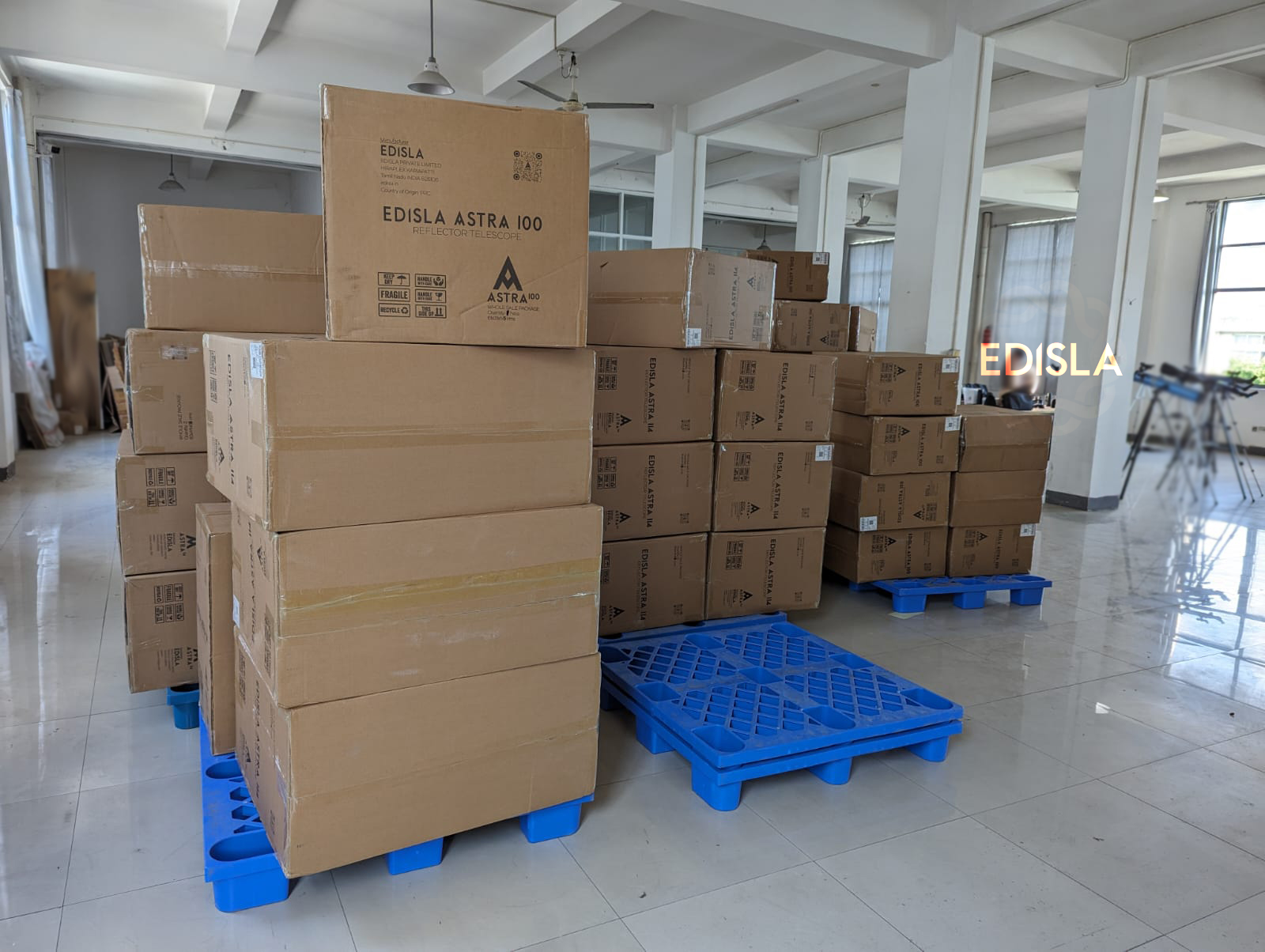
How to do basic Astro Photography? (DSLR and Mirrorless Camera) Guide from EDISLA
Photographing the sky is called astrophotography. With the right tools and techniques, anyone can capture stunning photos of galaxies, star clusters, nebulae, and other celestial objects.
The subject is so big that it's difficult to know where to start. Therefore, it's important to have a clear plan for how to approach it.
We'll help you out. Our beginner's guide to astrophotography shows you how to take pictures of the night sky in both simple and creative ways.
A hobby such as astrophotography requires two kinds of investment. You'll need a camera, at least one lens, and a few accessories, along with a warm coat for nights under the stars. For instance, a suitable camera for astrophotography can range from a DSLR to a dedicated astro-camera, with lenses varying in price depending on quality and size.
Time and patience are the second investment. It takes a lot of attempts to get this right the first time, and iterating on the same ideas to finally produce an image that's really cool. This is like running a marathon: You have to pace yourself, build up endurance, and keep persisting until you reach the finish line. It may take time and effort, but the rewards are worth it.
In this guide, we will discuss the equipment you'll need, how to plan your astro shoot, and what settings you need to take great images of the night sky. We will also discuss how to edit your images using some of the best photo editing apps on the market.
However, the first piece of advice is simple: give it a try.
Don't worry if you don't own a fancy camera. You'll be surprised at what a mobile phone is capable of, especially with the night modes on more recent models. If you don't try, you'll never know. As the famous Indian photographer Amit Kalantri once said: “A photograph shouldn't be just a picture, it should be a philosophy.”
Camera bodies and lenses
When shooting with a DSLR or mirrorless camera, set it to Manual mode - this applies to both exposure and focus. Astrophotography is best shot with manual focusing, since most cameras cannot focus on the night sky with automatic focusing, even in low light. You should use the screen on the back of the camera to focus carefully so that the stars appear as points rather than circles. By using the screen's controls, you can zoom in if you cannot stop the lens at infinity.
In low light situations, full frame cameras generally do better since they have bigger sensors. This advantage is becoming slimmer as megapixel counts increase (and photosites are smaller), and crop-sensor cameras are becoming more affordable and more capable of astrophotography.
Landscape and astrophotography are best suited to wide angle fast lenses in the 12-35mm range. Wide-angle focal lengths can capture both the night sky and some of the landscape in the foreground. A fast lens is one with a large maximum aperture, otherwise known as a small f-stop. In astrophotography, a lens with a maximum aperture of f/2.8 or lower is considered a fast lens.
Getting started with a lens like the Rokinon (Samyang) 14mm f/2.8 is a great idea. The Sigma f/1.4 14mm ART lens is a superb choice if you don't mind spending a little more. Even if you don't have a fast lens yet, you can still use the kit lens that came with your camera. Be sure to use the maximum aperture size available (usually f/4 on stock kit lenses).
Astrophotography requires long exposures, so a tripod is essential, since you can't hold the camera still by yourself, and resting it on a wall isn't always possible. Additionally, the tripod's smoothly tilting head allows you to position your camera perfectly to capture the perfect bit of sky.
A few extras
Remote Shutter Release
You can trigger your shutter with a cable button while minimizing vibrations. In the absence of a remote shutter release, use your camera's timer delay to ensure the camera does not move during an exposure. In DSLRs, mirror lockup prevents the mirror movement from causing vibrations, but it is not necessary for mirrorless cameras.
Intervalometer
Taking sequences of shots while shooting star trails requires an intervalometer. However, this form of astrophotography is quite advanced, so we wouldn't necessarily recommend buying one right away. Modern cameras come with them built in,so learn how to use them by reading your camera's manual.
Headlamp
When shooting at night, use a headlamp to keep your hands free and, if possible, use the red light mode on your camera if it has one. For lighting up the foreground in your images, you can use a headlamp. Another option is to cover the end of a flashlight with red plastic. It might be worth investing in a lens heater if you plan on shooting in cold temperatures. You can prevent condensation from entering your lens and ruining your pictures with these.
Getting ready for your astro shoot
Location
In the field of astrophotography, light pollution poses a serious challenge. To get detailed night sky pictures, you'll need a dark sky area, so avoid urban areas and street lights. Dark Site Finder and Light Pollution Map are useful websites for finding a suitable location to shoot, but if you want weather reports, and guidance on where to point your camera, the beststargazing apps are very helpful when choosing a location and letting you know the best time to shoot.
Subject
The night sky changes constantly throughout the year, so knowing what to expect and how to capture it is essential to astrophotography. The Stellarium and Starwalk 2 apps allow you to visualize the night sky for a given location at any time. However, meteor showers are unpredictable, and the weather can easily close in and ruin everything.
Setting up your camera for astrophotography
You can't pick one setting that works for everything. It just doesn't work that way in photography. You can, however, follow a few basic rules to get the best astro shot.
Choosing a camera shooting mode
Make sure the camera is in manual mode, or M. By doing this, you will be able to manually adjust shutter speed, aperture, and ISO.
Aperture
Almost always, you'll want your aperture to be wide, so set it to f/4 or lower. For best results, we recommend f/2.8 or lower, but use the maximum aperture your lens is capable of. In DSLRs and mirrorless cameras, the aperture is controlled by the camera body's wheel, but manual lenses and some lenses made for Sony mirrorless have an aperture ring. The lower the F number, the wider the aperture and the more light can be collected.
Image File Type
Make sure your camera records raw image files. Astrophotography can be divided into two main areas - photography and post-processing. To process your astro images at home, you'll need to shoot in raw so that you capture as much data as possible. Raw files contain the information from your camera's sensor without any processing. You'll get smaller files by capturing JPEGs, but the compression process throws away data you might want. Instead of shooting JPEGs, buy a bigger memory card.
Shutter Speed
If you don't want to make star trails, astrophotography is about capturing as much light as possible while avoiding visible star movement. To avoid star trails, you'll need a faster shutter speed the longer the focal length of your lens.
'500-rule' calculates the right shutter speed for any lens. You divide 500 by the focal length of your lens.
For a 20mm lens, 500 / 20mm = 25 seconds. However, this only applies to full frame cameras. When using a crop sensor camera, the crop factor has to be taken into account, so in this case I'd recommend 300 for APS-C cameras, and 250 for Micro Four Thirds. See how it looks with an exposure of 20 seconds, the longest you can leave the shutter open before stars trail. Adjust as needed.
ISO
The higher the ISO, the more light is amplified by your camera's sensor. Taking astrophotography requires high ISOs, but there's a trade-off. A higher ISO means more noise (a type of digital degradation), and every camera increases noise in a different way. There are people who slowly ramp it up, and there are others who make a big jump after a certain setting. It's a good idea to start at ISO 3200, but you might have to go down to ISO 1600 if there's too much ambient light or light pollution. Boost the ISO to 6400 if it's very dark, but don't go higher than that.
Focusing in the dark
Set your camera to manual focus - autofocus won't work in the dark. To preview the image on the camera's LCD screen, use the 'Live View' feature. Locate a bright star or really distant light source on the LCD display and digitally zoom in. Then, adjust the focus ring until the star or distant light source is as small as possible. Now you're focused!
Just compose your shot, take the shot, and wait for the image to appear on the LCD display - it may take some time for the camera to write the file to the memory card. To brighten your foreground, use a flashlight or your smartphone to light paint your subject during the exposure. Now that you know what works best for your location, you're well on your way to capturing your own night sky images.
Advice and tips
Foreground
If you're trying to balance light between the foreground and the night sky, we recommend taking multiple exposures and merging them when you edit. They'll require different settings. Getting your foreground shots an hour early, during blue hour, may even help because there's more light to work with. Unfortunately, this isn't always possible.
Reflections
It's a great opportunity to reflect the stars in the water if you're shooting the night sky near a lake. Depending on the conditions, you can do this several ways. It's better to do the hard work in the shoot, so we suggest changing your focus to the water, taking an exposure, then going back to your night sky and taking the same shot. Merge them later in edit.Depending on the conditions, you may need to adjust the shutter speed a bit - 20 seconds will capture the reflection of the stars, but you might get movement on the water. Shorter exposures might work better for your reflection shot, but you'll have to work harder to bring out the stars in post. Try Lightroom's linear gradient edits for bringing out the clarity and sharpness of reflections.
White balance
For astro shots, we'd recommend a slightly cooler white balance, but you can experiment with the manual settings, or the presets, to create interesting tints and variations. When you're close to an urban area, you would need a gradient filter to reduce noise if you're getting light pollution (we recommend cooling it right down and seeing what happens).
We hope this guide helped you learn the basics of astrophotography. Now you can take awesome pictures of the stars and make your friends jealous!


